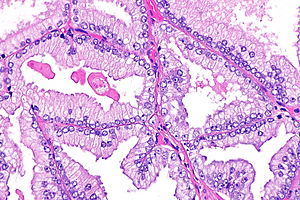Difference between revisions of "Pseudohyperplastic prostatic adenocarcinoma"
Jump to navigation
Jump to search
(+infobox & images) |
|||
| Line 22: | Line 22: | ||
| Symptoms = | | Symptoms = | ||
| Prevalence = uncommon | | Prevalence = uncommon | ||
| Bloodwork = +/-PSA elevated | | Bloodwork = +/-[[PSA]] elevated | ||
| Rads = | | Rads = | ||
| Endoscopy = | | Endoscopy = | ||
Revision as of 05:24, 11 April 2015
| Pseudohyperplastic prostatic adenocarcinoma | |
|---|---|
| Diagnosis in short | |
 Pseudohyperplastic carcinoma. H&E stain. | |
|
| |
| LM | medium to large glands with an atypical morphology (papillary or pseudopapillary infoldings, luminal undulations, branching or cystic dilatation), nuclear features of conventional prostate cancer (nucleoli, nuclear enlargement) |
| Subtypes | subtype of prostate carcinoma |
| LM DDx | benign prostatic tissue, foamy gland carcinoma |
| Site | prostate gland - see prostate cancer |
|
| |
| Prevalence | uncommon |
| Blood work | +/-PSA elevated |
| Treatment | see prostate carcinoma |
Pseudohyperplastic prostatic adenocarcinoma, also pseudohyperplastic adenocarcinoma is an uncommon type of prostate carcinoma that may mimic benign prostate.
General
- Uncommon <3% of cases in one series.[1]
- May mimic benign prostate.[1]
- Can be found with or without conventional prostatic adenocarcinoma (acinar type).
Microscopic
- Medium to large glands with an atypical morphology - key low power feature:
- Papillary or pseudopapillary infoldings, luminal undulations, branching or cystic dilatation.
- Nuclear features of conventional prostate cancer (nucleoli, nuclear enlargement).
Notes:
- Often associated with conventional (acinar) prostate adenocarcinoma.
- Pale abundant cytoplasm - similar to normal prostate.
DDx:
- Foamy gland carcinoma - often lack prominent nucleoli, smaller glands.
- Benign prostatic glands - esp. at low power.
Images
www:
- Pseudohyperplastic adenocarcinoma (webpathology.com).
- Pseudohyperplastic prostatic adenocarcinoma (nature.com).
See also
References
- ↑ 1.0 1.1 1.2 Arista-Nasr J, Martinez-Benitez B, Valdes S, Hernández M, Bornstein-Quevedo L (2003). "Pseudohyperplastic prostatic adenocarcinoma in transurethral resections of the prostate". Pathol. Oncol. Res. 9 (4): 232–5. doi:PAOR.2003.9.4.0232. PMID 14688829.
- ↑ Zhou, Ming; Magi-Galluzzi, Cristina (2006). Genitourinary Pathology: A Volume in Foundations in Diagnostic Pathology Series (1st ed.). Churchill Livingstone. pp. 77. ISBN 978-0443066771.




